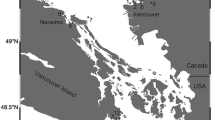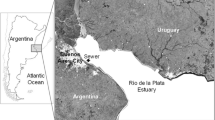Abstract
A laboratory experiment was conducted to measure the accumulation of selected polychlorinated compounds by marine benthos exposed to environmentally contaminated sediment. Sandworms (Nereis virens), clams (Macoma nasuta), and grass shrimp (Palaemonetes pugio) were exposed to sediment collected from the Passaic River, New Jersey. All three species accumulated 2,3,7,8-tetrachlorodibenzo-p-dioxin (2,3, 7,8-TODD), 2,3,7,8-tetrachlorodibenzofuran (2,3,7,8-TCDF) and polychlorinated biphenyls (PCBs) from the sediment. In addition, a recently identified sulfur containing analog of tetrachlorinated dibenzofurans, 2,4,6,8-tetrachlorodibenzothiophene (2,4,6,8-TCDT), accumulated in the three species.
Accumulation factors (AFs) were calculated (([organism]/lipid) / ([sediment]/total organic carbon)) and used to compare results among species and compounds. These comparisons showed that AFs measured for clams reached steady-state levels rapidly (10 days); however, steady-state Al's values were not achieved until 70–120 days in sandworms. Grass shrimp were exposed to test sediments for only 28 days; therefore, steady-state concentrations could not be determined for this species.
Although final contaminant concentrations were highest in the sandworms, AFs were generally higher for the clams and shrimp and lower for the sandworms. The AFs for 2,4,6,8-TCDT were significantly higher for shrimp than for sandworms and clams. PCB 153 showed higher AF values than those of the other compounds studied.
Clams showed preferential accumulation of lower molecular weight PCB congeners which may be due to the very low lipid content in this species. Sandworms and especially shrimp appeared to metabolize congeners 52, 101, and 151 which all contain vicinal hydrogens in the meta and para regions of the molecule.
Similar content being viewed by others
References
Ballschmiter K and Zell M (1980) Analysis of polychlorinated biphenyls (PCBs) by glass capillary gas chromatography. Fresenius Z Anal Chem 302:20–31
Belton TJ, Hazen R, Ruppel BE, Lockwood K, Mueller R, Stevenson E and Post JJ (1985) A study of dioxin (2,3,7,8-tetrachlorodibenzo-pdioxin) contamination in select finfish, crustaceans and sediments of New Jersey waterways. Office of Science and Research, New Jersey Department of Environmental Protection, Trenton
Boon JP, Eijgenraam F, Everaarts JM and Duinker JC (1989) A structure-activity relationship (SAR) approach towards metabolism of PCBs in marine animals from different trophic levels. Mar Environ Res 27:159–176
Bopp RF, Gross ML, Tong H, Simpson HJ, Monson SJ, Deck BL and Moser FC (1991) A major incident of dioxin contamination: Sediments of New Jersey estuaries. Environ Sci Technol 25:951–956
Bruggeman WA, Martron LBJM, Kooiman D and Hutzinger O (1981) Accumulation and elimination kinetics of di-, tri- and tetra chlorobiphenyls by goldfish after dietary and aqueous exposure. Chemosphere 10:811–832
Buser H-R, Dolezal IS, Wolfensberger M and Rappe C (1991) Polychlorodibenzothiophenes, the sulfur analogues of the polychlorodibenzofurans identified in incineration samples. Environ Sci Technol 25:1637–1643
Buser, H-R and Rappe C (1991) Determination of polychlorodibenzothiophenes, the sulfur analogues of polychlorodibenzofurans, using various gas chromatographic/mass spectrometric techniques. Anal Chem 63:1210–1217
Duinker, JC, Hillebrand MTJ and Boon JP (1983) Organochlorines in benthic invertebrates and sediments from the Dutch Wadden Sea; identification of individual PCB components. Netherlands J Sea Res 17:19–38
Ernst W, Goerke H and Weber K (1977) Fate of14C-labelled di-, triand pentachlorobiphenyl in the marine annelidNereis virens. II. Degradation and faecal elimination. Chemosphere 9:559–568
Fries CR and Lee RF (1984) Pollutant effects on the mixed function oxygenase (MFO) and reproductive systems of the polychaeteNereis virens. Mar Biol 79:187–193
Goerke H (1984) Temperature-dependent elimination of 2,4,6,2′,4′-pentachloro[U-14C]biphenyl inNereis virens (Polychaeta). Arch Environ Contain Toxicol 13:347–355
Goerke H and Weber K (1990) Population-dependent elimination of various polychlorinated biphenyls inNereis diversicolor (Polychaeta). Mar Environ Res 29:205–226
Hahn ME, Poland A, Glover E, and Stegeman JJ (1993) The Ah receptor in marine animals: Phylogenetic distribution to cytochrome P450IA inducibility. Mar Environ Res 34:87–92
Isensee AR and Jones GE (1975) Distribution of 2,3,7,8-tetrachlorodibenzo-p-dioxin (TCDD) in aquatic model ecosystems. Environ SciTechnol 9:668–672
Kammann U, Knickmeyer R and Steinhart H (1990) Distribution of hexachlorobenzene in different tissues of the dab (Limanda limanda) in relation to lipid polarity. Bull Environ Contain Toxicol 45:552–559
Kuehl DW, Cook PM, Batterman AR, Lothenbach D and Butterworth BC (1987) Bioavailability of polychlorinated dibenzo-p-dioxins and dibenzofurans from contaminated Wisconsin River sediment to carp. Chemosphere 16:667–679
Lake JL, Rubinstein N and Pavignano S (1987) Predicting bioaccumulation: Development of a simple partitioning model for use as a screening tool for regulating ocean disposal of wastes. In: Fate and Effects of Sediment-Bound Chemicals in Aquatic Systems. Proceedings of the Sixth Pellston Workshop, Florissant, CO, 12–17 August 1984. SETAC Special Publication Series, Pergamon Press, NY, pp 151–166
Lake JL, Rubinstein NI, Lee H II, Lake CA, Heltshe J and Pavignano S (1990) Equilibrium partitioning and bioaccumulation of sediment-associated contaminants by infaunal organisms. Environ Toxicol Chem 9:1095–1106
Landrum PF (1988) Toxicokinetics of organic xenobiotics in the amphipod,Pontoporeia hoyi: Role of physiological and environmental variables. Aquatic Toxicol 12:245–271
Mehrle PM, Buckler DR, Little EE, Smith LM, Petty JD, Peterman PH, Stalling DL, De Graeve GM, Coyle JJ and Adams WJ (1988) Toxicity and bioconcentration of 2,3,7,8-tetrachlorodibenzodioxin and 2,3,7,8-tetrachlorodibenzofuran in rainbow trout. Environ Toxicol Chem 7:47–62
Norwood CB, Hackett M, Pruell RJ, Butterworth BC, Williamson KJ and Naumann SM (1989) Polychlorinated dibenzodioxins and dibenzofurans in selected estuarine sediments. Chemosphere 18:553–560
Peterman PH, Smith LM, Stalling DL and Petty JD (1986) Identification of chlorinated biphenylenes and other polycyclic aromatic compounds formed from the incineration of PCB-dielectric fluids at a capacitor plant's disposal site. In: Proceedings of the 34th Annual Conference on Mass Spectrometry and Applied Topics, Cincinnati, OH, June 8–13, 1986, pp 486–487
Peterman PH, Lebo JA and Major HJ (1988) Accurate mass determinations of polychlorinated dibenzothiophenes in soil from a capacitor plant's incineration site. In: Proceedings of the 36th Annual Conference on Mass Spectrometry and Applied Topics, San Francisco, CA, June 1988, pp 240–241
Randall RC, Lee H II, Ozretich RJ, Lake JL and Pruell RJ (1991) Evaluation of selected lipid methods for normalizing pollutant bioaccumulation. Environ Toxicol Chem 10:1431–1436
Rappe C, Bergqvist P-A, Swanson S, Belton T, Ruppel B, Lockwood K and Kahn PC (1989) Levels and patterns of PCDD and PCDF contamination in fish, crabs and lobsters from Newark Bay and the New York Bight. Abstract, Ninth International Symposium on Chlorinated Dioxins and Related Compounds, Toronto, Ontario, Canada
Rappe C, Bergqvist P-A, Kjeller L-O, Swanson S, Belton T, Ruppel B, Lockwood K and Kahn PC (1991) Levels and patterns of PCDD and PCDF contamination in fish, crabs, and lobsters from Newark Bay and the New York Bight. Chemosphere 22:239–266
Roberts JR, deFrietas ASW and Gidney MAJ (1977) Influence of lipid pool size on bioaccumulation of the insecticide chlordane by northern rednose suckers (Moxostoma macrolepidotum). J Fish Res Board Can 34:89–97
Rubinstein NI, Lake JL, Pruell RJ, Lee H II, Taplin B, Heltshe J, Bowen R and Pavignano S (1987) Predicting bioaccumulation of sediment associated organic contaminants: Development of a regulatory tool for dredged material evaluation. US Environmental Protection Agency Technical Report D-87, Narragansett, RI for the US Army Corps of Engineers, Vicksburg, MS
Rubinstein NI, Pruell RJ, Taplin BK, LiVolsi JA and Norwood CB (1990) Bioavailability of 2,3,7,8-TCDD, 2,3,7,8-TCDF and PCBs to marine benthos from Passaic River sediments. Chemosphere 20:1097–1102
van der Oost R, Heida H and Opperhuizen A (1988) Polychlorinated biphenyl congeners in sediments, plankton, molluscs, crustaceans, and eel in a freshwater lake: Implications of using reference chemicals and indicator organisms in bioaccumulation studies. Arch Environ Contain Toxicol 17:721–729
Waldichuk M (1990) Dioxin pollution near pulpmills. Mar Pollut Bull 21:365–366
Wenning RJ, Hams MA, Paustenbach DJ and Bedbury H (1992) Potential sources of 1,2,8,9-tetrachlorodibenzop-dioxin in the aquatic environment. Ecotox Environ Safety 23:133–146
Wenning RJ and Paustenbach DJ (1992) Comment of “A major incident of dioxin contamination: Sediments of New Jersey estuaries”. Environ Sci Technol 26:1254–1256
Author information
Authors and Affiliations
Rights and permissions
About this article
Cite this article
Pruell, R.J., Rubinstein, N.I., Taplin, B.K. et al. Accumulation of polychlorinated organic contaminants from sediment by three benthic marine species. Arch. Environ. Contam. Toxicol. 24, 290–297 (1993). https://doi.org/10.1007/BF01128727
Received:
Revised:
Issue Date:
DOI: https://doi.org/10.1007/BF01128727




